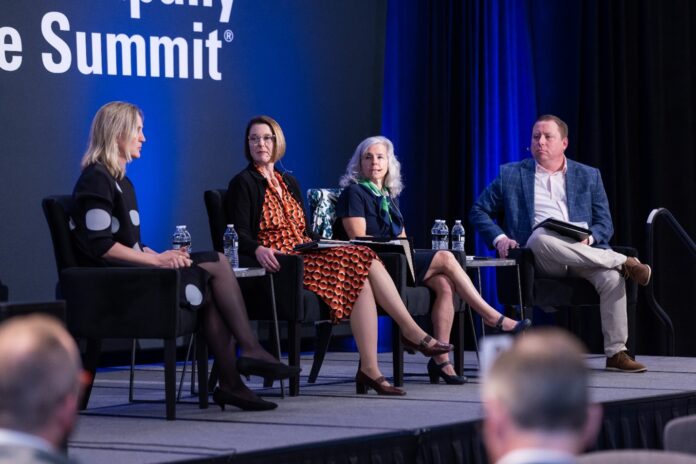When board dysfunction is the topic under discussion, it would be easy to fixate on the meandering conversations, the unhealthy debate and the poorly put-together agendas. But let’s look at it from the opposite perspective: What is the hallmark of a well-functioning board?
To Gina Hoagland, director of Tacony, Essex Industries and Keeley Companies, among others, it means having “the right people in the right seats on the right committees and in the right structures.” It also means a refined process, with good agendas, robust debate and the participation of all directors.
“People are listening. They are behaving as good human beings,” says Hoagland, who is chairman, CEO and principal at Collaborative Strategies Inc. “Directors are speaking more than management. It’s not just report-out board meetings where management broadcasts information and the directors are just sitting there nodding their heads. It’s a spirit of engagement.”
Becky Pratt, finance committee chair of Wheatsfield Co-op and advisory board member of PrairieFire Wealth Planning, says a functioning board includes directors demonstrating diverse thoughts and perspectives but also features “patterns of creativity and collaboration rather than patterns of survival and power.”
“A big piece of that is leadership, stamina, being engaged and being curious. When I say leadership and stamina, it’s exercising initiative and resilience to pursue bold and relevant action toward a shared mission,” says Pratt, who is founder and president of Mattan Pratt Consulting LLC. “And that’s done in the face of others who would potentially be concerned about disruption, demonstrating clarity, resolve, connection and care as you face leadership challenges.”
According to Cassandra Kelly, chair of FutureFeed and Treasury Corporation of Victoria, what makes a board great is “a commitment to each other to serve and bring your collective wisdom to the table for the best outcome.”
“I’ve got your back. You’ve got mine,” says Kelly, who is founder and senior advisor for Pottinger and founder of C-Change. “And that means through inquiry. It means through checking in on each other — not just another’s thoughts but also their well-being — so that the board has alignment as it relates to culture and to the processes that support good decision-making and good discussion. Because if we’re misaligned, that leads to fracturing.”
Kelly also believes that one of the prominent signs of a healthy, well-functioning board is the ability to not only manage risks but take them as well. Being overly risk-obsessed, she says, is to possibly miss valuable opportunities.
“It is very easy for us in current-day boards to be so concerned for reputation and the management of risk that we actually don’t go after opportunities,” says Kelly. “To take advantage of opportunities, we have to somehow learn to wrestle with that discomfort of ‘I don’t know.’ We’ve got to live in a world that’s quite uncertain. But there are, in the gaps, opportunities.”
Speaking of risks, Pratt believes that one of the key signs that a board might be seeping into a dysfunctional state is falling into groupthink or taking on a “check-the-box mindset.”
“Falling into that state is really important to consciously prevent. I say that because there are intuitive, unintentional and sometimes irrational pressures to conform within groups,” says Pratt. “As directors, when we’re engaged and we’re operating smoothly and we can remember what our role is, and we know it’s to ask probing questions, we can resist that pressure. But if we’re distracted, if we’re under stress, our ability to resist that pressure is biologically impaired.”
If a director begins to believe their board is falling into dysfunction, Kelly says it is key to call it out immediately.
“If you allow the dysfunction to persist for too long, the malfunction that can result can be very significant,” says Kelly. “So you have to ask, ‘Can I go to the chair? Who can I speak to? Do I need to go to a family member?’ Try to resolve it easily and have safe spaces for grown-up conversations about the root of the problem.”
While Kelly mentions speaking to the chair, sometimes it can be the chair who is the issue. And Kelly, who is a chair, believes being tuned into the onset of potential problems is one of the biggest parts of her role.
“I think that is one of my most important jobs. Running a board meeting is like being a conductor of an orchestra,” says Kelly. “I believe as a chair it is one of your most important roles to create a safe space for constructive, collaborative discussion. As in an orchestra, if everyone plays their part well, we don’t just sound better, we decide better.”
In her time as a director, Hoagland has served for all manner of companies, including family companies. While she notes that some factors causing dysfunction are common to family as well as nonfamily boards, she has also seen family boards that suffer from what she calls “kitchen-table dynamics.”
“There are these family patterns that have been going on for 20, 30 or even 40 years. And our job in that boardroom is to do the right thing for the company,” says Hoagland. “The discussion should be about what’s best for the company, not what a certain family member is trying to achieve personally.”
Sometimes, getting a family board meeting on track requires reminding family shareholders of that fact.
“I spend a lot of time saying, ‘The argument over who’s using the lake house is not a board matter. So we’re going to take that out of the board meeting,’” says Hoagland. “Families have those layered dynamics of all those interactions and patterns. It introduces a complicating factor, but it can be dealt with. You just have to be willing to have the conversation.”



